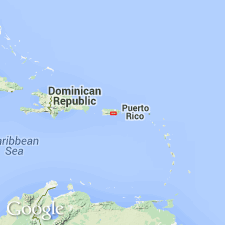
- Usage in publication:
-
- Torrecilla Breccia*
- Modifications:
-
- Named
- Dominant lithology:
-
- Breccia
Summary:
Strata previously described as informal formation D in the Cayey quadrangle (Berryhill and Glover, 1960), informal formation K in the Comerio quadrangle (Pease and Briggs, 1960), and pre-Robles rocks in the Barranquitas quadrangle (Briggs and Gelabert, 1962), are here named the Torrecilla Breccia. Includes the Aguas Buenas Limestone Member at the base (reassigned from formations D and K) and the Barros Tuff Member at the top. Thickness ranges from 0 to 2,050 m. Unconformably overlies formations A, B, C, and J; underlies the Robles Formation. Age is Early Cretaceous (Albian). Aguas Buenas Limestone Member is here redefined, removed from the Fajardo Formation, and assigned to the base of the Torrecilla Breccia. Type locality designated where 30 m of dark-gray finely crystalline, lenticular, reef limestone with rudist and gastropod fauna are exposed. Overlies hydrothermally altered volcanic rock; top is faulted out at type locality, but nearby it is overlain by sandstone and siltstone that grade into volcanic strata of the Torrecilla. Age is Early Cretaceous, probably Albian, based on fossils.
Source: GNU records (USGS DDS-6; Reston GNULEX).

- Usage in publication:
-
- Torrecilla Breccia*
- Modifications:
-
- Overview
- AAPG geologic province:
-
- Caribbean region
Summary:
The Torrecilla Breccia occurs in central Puerto Rico and consists of hyaloclastite breccia and associated lava flows, subordinate volcanic sandstone, conglomerate, and siltstone, and minor limestone (Aguas Buenas Limestone Member). Maximum estimated thickness is 2000 meters. The Torrecilla is of Early Cretaceous age.
Source: GNU records (USGS DDS-6; Reston GNULEX).
For more information, please contact Nancy Stamm, Geologic Names Committee Secretary.
Asterisk (*) indicates published by U.S. Geological Survey authors.
"No current usage" (†) implies that a name has been abandoned or has fallen into disuse. Former usage and, if known, replacement name given in parentheses ( ).
Slash (/) indicates name conflicts with nomenclatural guidelines (CSN, 1933; ACSN, 1961, 1970; NACSN, 1983, 2005, 2021). May be explained within brackets ([ ]).

